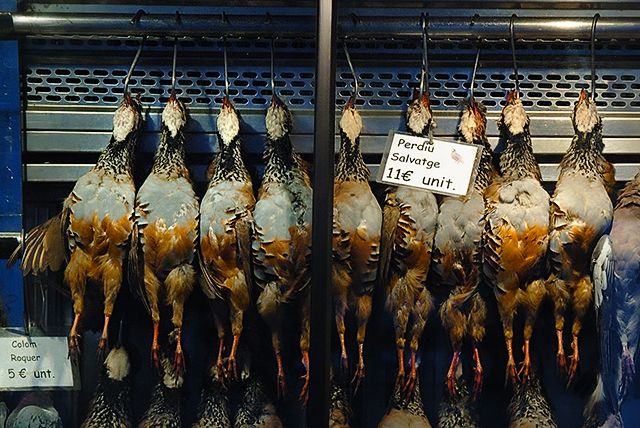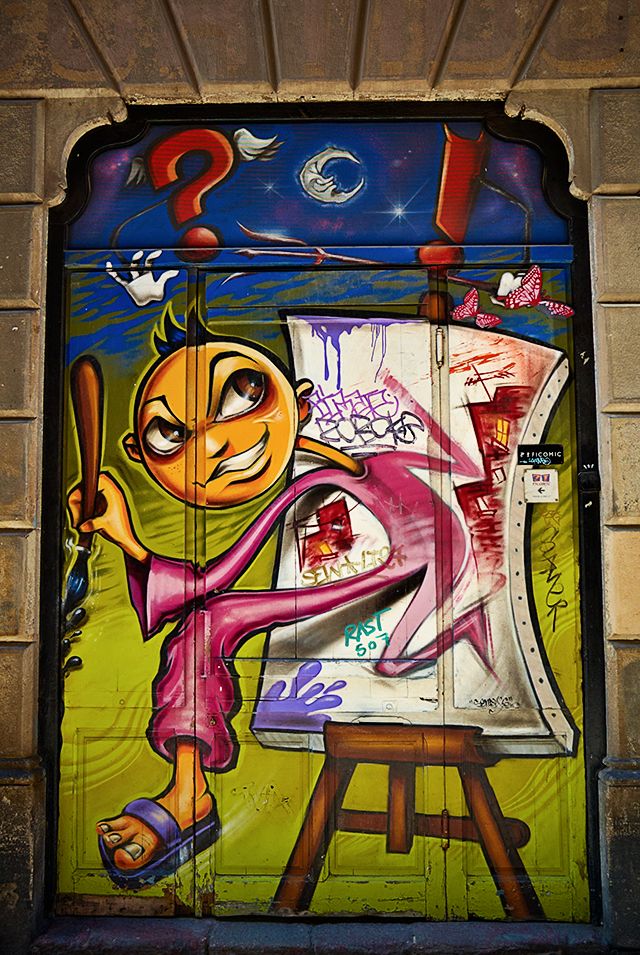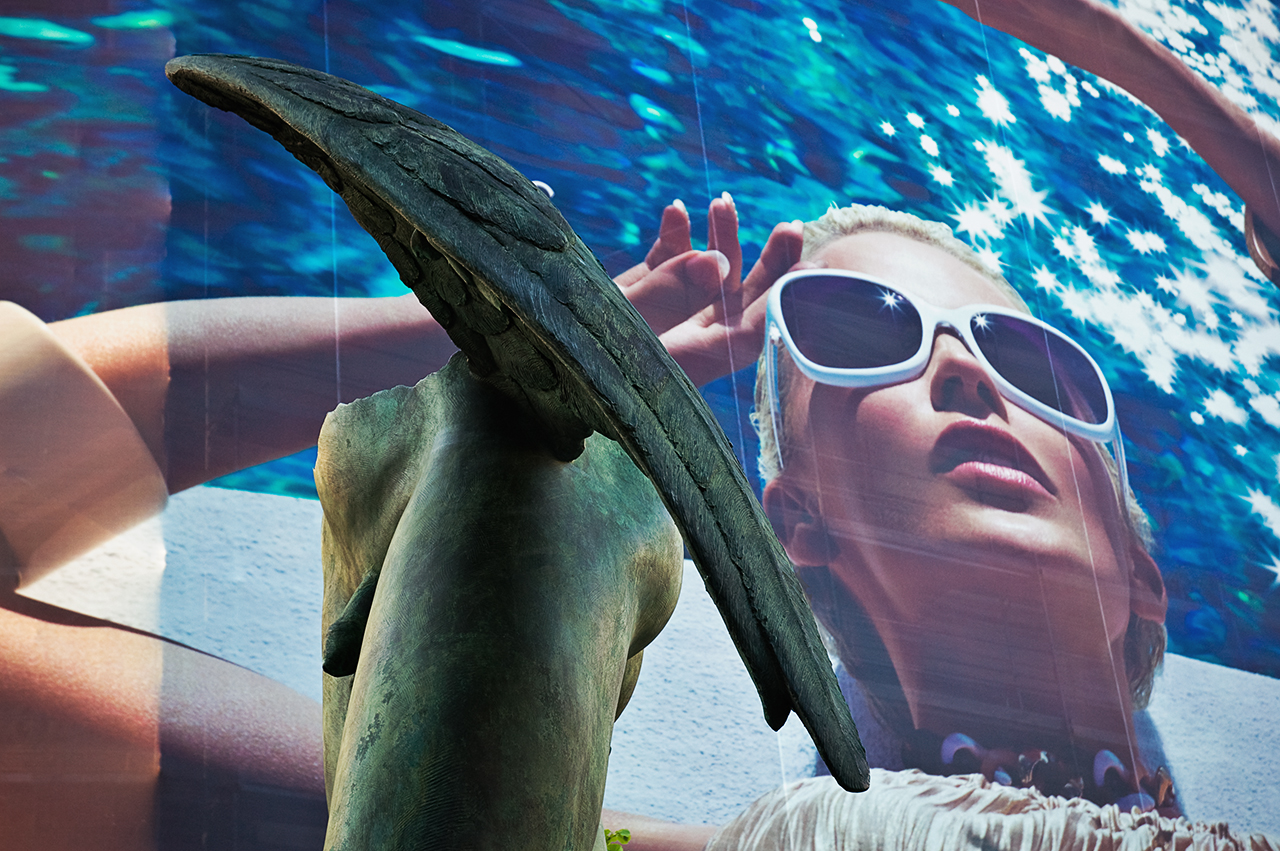Barcelona photos: Daily photographs of Barcelona, Spain. Pictures of a modern city with travel tips in a personal photoblog. A photography and travel site. Art, architecture, people and traditions. Travel to Barcelona through my camera, know more about our city and towns nearby. Welcome!
Wanna be featured?
August 15, 2025
Barcelona Cathedral’s Pietà: A Gothic Masterpiece with a Secret Past
September 12, 2022
Sant Jordi Fountain Faucet at Barcelona Cathedral Cloister
May 01, 2014
Ceiling Frescoes by Salvador Dali at Palace of the Wind, Dali Museum
Palacio del Viento
Dalí created this painting in his workshop in Portlligat, but it was eventually placed on a large scaffolding and installed in his Theatre-Museum. On the first floor of the town theater, the Sala Palau del Vent (‘Wind Palace Room’) was the site of Dalí’s first exhibition in 1919. The painting is based on the poem "L'Empordà" by Joan Maragall, which alludes to the Empordà region of Spain and the tramontana, a strong wind that blows through the region.
In the center of the painting, Dalí depicts himself and Gala in a forced perspective, creating an allegorical representation of the different stages of his life. The painting can be seen as a kind of idyllic journey through Dalí's dreamlike memories. At the end of the painting, Dalí again depicts himself and Gala, this time contemplating the ship of destiny that is about to depart.
Some of the key elements of the painting include:
- A rain of gold coins falling on the viewer, which Dalí claimed was one real coin.
- A reference to Lullian wheels, a type of symbol used by the Catalan mystic Ramon Llull.
- Elephants with insect limbs.
- The outlined silhouettes of the princes of Spain, who are the current king and queen of Spain.
- The silhouette of the photographer and friend of Dalí, Melitó Casals, "Meli."
The painting is a complex and allegorical work that offers a unique glimpse into Dalí's life and work. It is a masterpiece of Surrealist art, and it is one of the most important works in the Dalí Theatre-Museum.
Salvador Dalí's painting The Palace of the Wind is a complex and enigmatic work that is full of symbolism. It was created between 1969 and 1973 for the ceiling of the "sala nobile" or rest room of the old municipal theatre in Figueres, Spain. The painting is now on display in the Dalí Theatre-Museum, which is housed in the same building.
The painting consists of five panels, each of which is filled with images that are both familiar and strange. The central panel depicts a large, golden sun that is surrounded by a swirling vortex of clouds. The clouds are populated by a variety of figures, including a woman with a long neck, a giant lobster, and a group of musicians. The other panels depict a variety of other scenes, including a landscape with a castle, a seascape with a boat, and a cityscape with a cathedral.
The Palace of the Wind is a visually stunning work that is full of Dalí's signature surrealist imagery. The painting is a testament to Dalí's incredible imagination and his ability to create images that are both beautiful and disturbing.
The Creation of the Painting
Dalí began working on The Palace of the Wind in 1969, shortly after the purchase of the old municipal theatre in Figueres. The theatre was originally built in 1847, but it had fallen into disrepair by the time Dalí acquired it. Dalí planned to transform the theatre into a museum dedicated to his work, and The Palace of the Wind was to be one of the centerpieces of the museum.
Dalí worked on the painting in several different stages. The first panel was completed in 1970, and it was hoisted into place on the ceiling of the sala nobile on November 13, 1970. The painting was taken down the next day, however, so that the restoration of the theatre could continue.
Dalí continued working on the painting in his studio at Portlligat during 1971-72. He completed the central part of the painting during this time, and he also added the side panels. The entire painting was finally put in place on the ceiling of the sala nobile in 1972 but officially declared completed by the author in 1973.
The Symbolism of the Painting
The symbolism of The Palace of the Wind is complex and has been interpreted in many different ways. Some scholars believe that the painting is a representation of the Empordà region of Spain, where Dalí was born and raised. The Empordà is a region that is known for its winds, and the swirling vortex of clouds in the painting could be seen as a representation of the region's strong winds.
Other scholars believe that the painting is a more personal allegory, representing Dalí's own life and work. The central panel of the painting depicts a large, golden sun that is surrounded by a swirling vortex of clouds. The sun could be seen as a representation of Dalí himself, while the clouds could be seen as representing the challenges and obstacles that he faced in his life.
The other panels of the painting depict a variety of other scenes, including a landscape with a castle, a seascape with a boat, and a cityscape with a cathedral. These scenes could be seen as representing different aspects of Dalí's life and work. The castle could be seen as a representation of Dalí's childhood home, while the seascape could be seen as a representation of his travels. The cityscape could be seen as a representation of his life in Barcelona and Figueres.
The Legacy of the Painting
The Palace of the Wind is one of Dalí's most famous paintings, and it is a centerpiece of the Dalí Theatre-Museum in Figueres
December 03, 2013
Casa Comalat Backside at Carrer Corsega 316, Barcelona

Art Nouveau Balconies
October 29, 2013
The Mae West Room at Dali Theatre-Museum in Figueres, Catalonia

This work, is indeed based upon one of his paintings: Mae West's Face which May be Used as a Surrealist Apartment, 1934–35.
Mae West had a clear influence on the Catalan artist, particularly in the movie called: She Done Him Wrong (1933) by Lowell Sherman, where she plays a very seductive saloon owner. An important part of the illusion, in the foreground of the composition, are those lips that reminds of a cozy sensual couch, that slightly resembles a wood-and-satin piece of furniture by Dali known as The Mae West Lips Sofa (1937) although that one was pink, or better said, "shocking pink" as the lipstick shade inspired by the actress, developed by fashion designer Elsa Schiaparelli.
For those of you who have not visited the Dali Museum yet, let me tell you that to see the face you have to climb a small set of stairs and look through a sort of circular magnifying glass to better appreciate the isolated objects that integrate the composition.
Salvador Dali, was born in this location in 1904 and was even baptized in the church right in front of the museum. Nevertheless, he did not spend all his life in his hometown.
Dali studied at the Academia de San Fernando (School of Fine Arts) in Madrid in 1922 although he was suspended later, but not for academic reasons. He went many times to Paris and was influenced by Picasso, among other artists. All in all, he became world known as a surrealist artist in the period that goes from 1929 to 1937 in which he produced many of those paintings we admire so much today, such as ‘The Persistence of Memory’ (1931). Yes, the one with the melting watch!
The artist also visited the United States where he lived for eight years with his wife Gala. From 1950 to 1970 his works included new themes, on many occasions, of religious nature but also erotic or recalling his childhood as in previous years. Gala was also present in his paintings often. After she died in 1982, he was no longer the same, and his health was affected by a motor disorder until his death in 1989.
December 23, 2009
Cogwheels: Industrial Reminiscence of Catalonia's Past
December 09, 2009
Still Life: Wild Partridge Showcase, La Boqueria Market, Barcelona

October 21, 2009
Ficomic, Carrer Palau 4, Barcelona: Street Art on Door

May 30, 2009
Barcelona Head, 1992 by Roy Lichtenstein

Roy was appointed Amici di Barcelona in 1993 by Pasqual Maragall, city mayor during the Olympics. In fact this sculpture was inaugurated for the 1992 Barcelona games as part of the important transformation the wharves underwent during the early 90s. Its 64 feet of concrete and ceramics reminds you of some famous pop art work by the same author: Girl With Hair Ribbon, 1965.
February 20, 2009
Flashy Wall Mural, Barcelona
August 26, 2008
Dali Standing on Barcelona Balcony
July 04, 2008
La Unión y el Fénix Building, Passeig de Gracia 21, Barcelona, Spain

April 30, 2008
Holy Water Font or Basin Made With Shell, Colonia Guell's Crypt, Barcelona, Spain
![Holy Water Font or Basin Made With Shell, Colonia Guell's Crypt, Barcelona, Spain [enlarge]](https://i63.photobucket.com/albums/h135/carloslorenzo/Holy_Water_Font-Shell_.jpg)
Stationary fonts like this are placed at the entrance to churches as you all know but I am sure you never saw a holy water font made with an enormous shell nor have you seen perhaps such wonderful ironwork pedicle. Nothing is common and ordinary when you enter Gaudi's crypt at Colonia Guell. The place has columns, altar, stain glass and pews as any other church but you have to be prepared to digest the degree of variation of the holy elements. A church was supposed to be on top of the crypt, as the latter was part of a bigger project which started in 1908. In 1917 one year after Gaudi's art patron and friend, Eusebi Guell, died, the work was finally stopped. As you can guess foundations are very solid. Columns are made of basaltic rock and different kinds of bricks. The ceiling is vaulted in the most traditional gothic style. Every arch, every pillar, was precisely calculated with small sacks full of pellets which were tied to the ceiling in Gaudi's workshop by means of small pieces of cloth and string making up what is known as a stereostatic model. The weight of every sack was proportional to the load every arch element had to hold. But everything here is hard to imagine without visiting Colonia Güell of course. By the way, there were some posts in Barcelona Photoblog some time ago that might help: Caprice Supreme of Architecture, Modernist Door and Mosaic, Futurist Windows and Stained Glass
April 08, 2008
Mitoraj: Art and Publicity in Barcelona

When I took this picture some months ago, last summer I think, and I was about to publish it here I suddenly found out that someone else had posted a very similar shot, from the same place. I thought the scene wasn't original enough to show. Things like that happen in public places, you are not the only one around shooting for the web. But now I think, hey, this is my picture, so what the heck, the fact someone posted it first doesn't make me a cheater. So here it is, back from my archives, a detail of one of Igor Mitoraj's itinerant sculptures against a very idyllic billboard at Rambla Catalunya. By the way, the lady, the pose, the golden reflections remind me of (now you will think I went crazy, hmm, more or less) that famous The Graduate scene where Dustin Hoffman is laying back on a beach mattress in the middle of the swimming pool with a hand behind his neck and wearing sunglasses. Need a little help?: The Sounds of Silence. I reckon the comparison is a little ackward, but you know how weird daydreaming can get to be sometimes. How about adding some common sense to the photograph by recalling other Mitoraj sculptures featured in Barcelona Photoblog in the past: A Closer Look on Igor Mitoraj's Sculpture , Grande Toscano, Mysterious Faces, Lying Head and Hold Me Tight.
March 15, 2008
Artistic Office Building- Carrer Londres 106 - Barcelona
Well the title today says it all. This is just an office building covered with modern paintings in the form of boxes, where orange and red are predominant, clearly visible if you are walking anywhere near the intersection of Diagonal Avenue, Aribau and Londres streets. To be more precise the right address is Londres 106. The boxes are symmetrically displayed on the façade from street level till the highest floors of the building. I added an Indian summer effect to the background to make the paintings stand out a little bit but the colors in the boxes are real.
October 26, 2007
Women Paintings at Maremagnum Promenade, Barcelona
These paintings of women wearing veils, hats or ties at Maremagnum promenade or Passeig D'Itaca looked so beautiful I decided to take a snap agaisnt the artist's will (check google maps below). I just don't know what gets into their minds when they see a big camera. You come with a small compact and nothing happens, you stick out some big lens and they immediately jump at your throat. Take it easy man, this is free advertising for your work which on the other hand is amazing and hypnotic, according to my opinion. Please buy him some paintings and tell him I was the one he shunned the other day.
October 15, 2007
Art With Exclamation Marks: Stained Glass at Sagrada Familia
In this picture I tried to isolate these three stained glass windows because of an unusual and reasonable resemblance with exclamations marks. Quality of the image is out of the question, that is, don't ask cause it is awful. I just wanted to highlight the punctuation marks and how they might be used as part of some publicity campaign or something to emphasize the work of Gaudi and his art, art with exclamation marks!!!
June 28, 2007
Mosaic Work Called Trencadis by Gaudi at Park Guell
June 26, 2007
Guell Crypt: Caprice Supreme of Architecture

June 22, 2007
Lorenzo Quinn: Beer Pump Sculpture for Barcelona Auditorium
The bronze sinewy arm holding a golden jar of San Miguel beer is just a tiny drop in the vast collection of the famous sculptor born in Rome in 1966, son of Anthony Quinn and Jolanda Addolori and brother of four.
At present he lives in Barcelona with his wife Giovanna and their two sons, Christopher and Nicolás.
He studied art at the American Academy of Fine Arts in New York.





